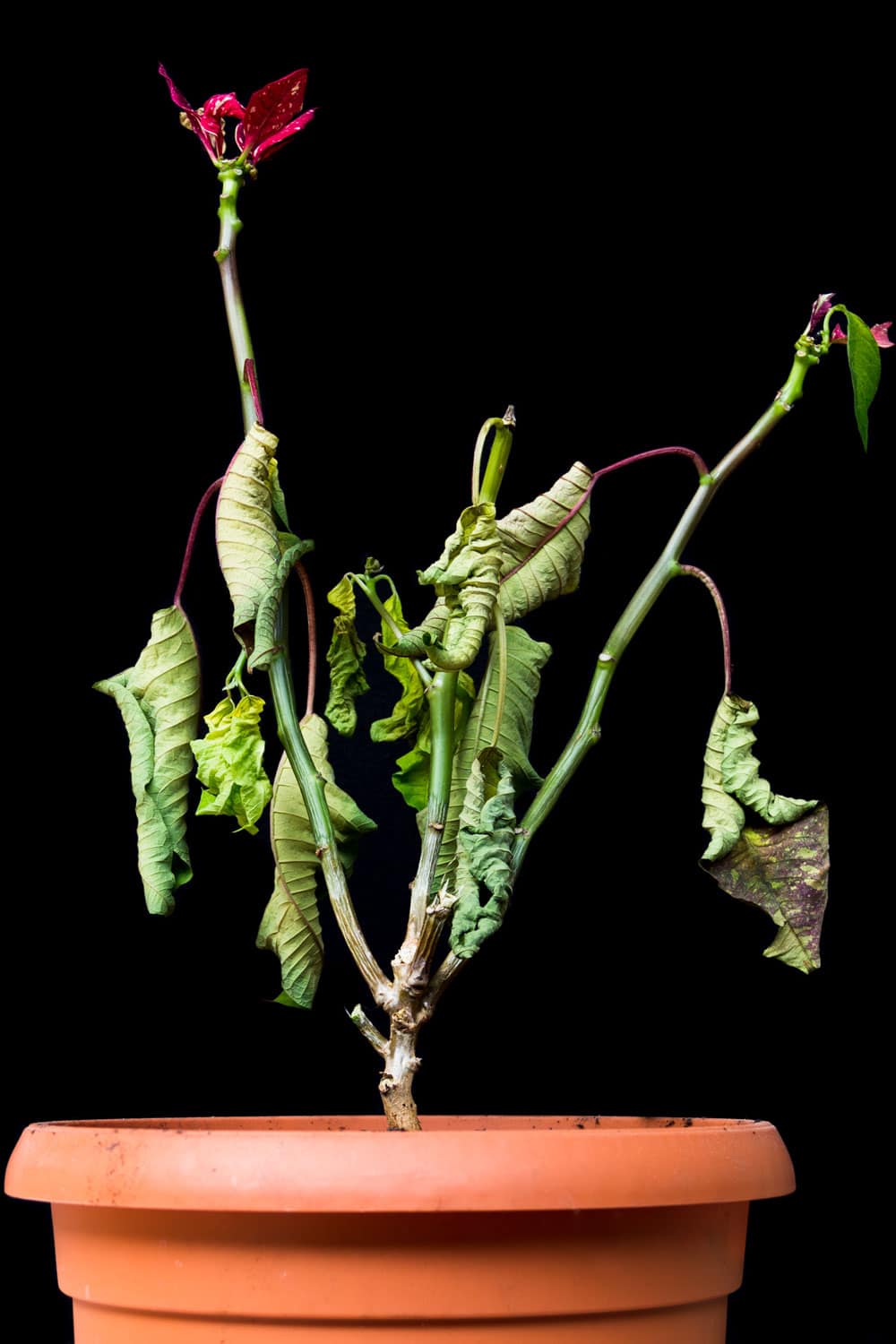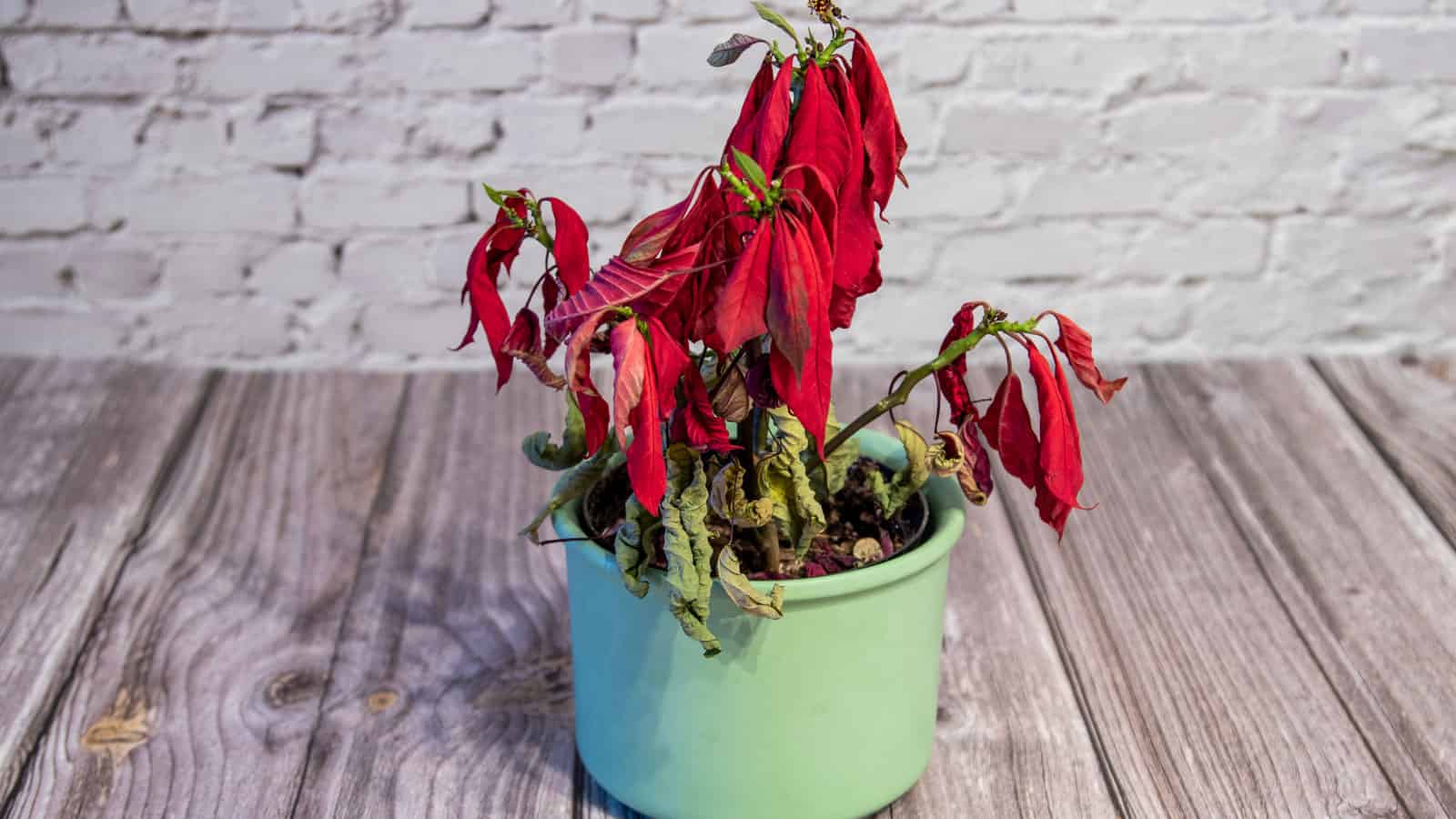Poinsettias are the quintessential holiday plant, their vibrant red color leaves a festive staple in many homes during the Christmas season.
However, maintaining the perfect potted poinsettia can sometimes be challenging.

If you've ever found yourself staring at yellow leaves or a wilting plant, it's important to recognize that these are common issues, and often, there's a straightforward solution.
Below, we'll discuss the possible problems you might encounter with a poinsettia and how to deal with them.
Poinsettia's Natural Cycle
Poinsettias, with their vibrant red leaves, are synonymous with the holiday season.

Knowing their natural growth cycle can help you keep them healthy year-round.
These plants are "short-day" plants, meaning they bloom when the nights are longer than the days.
Spring & Summer
After the blooming season, reduce watering to allow your poinsettia to rest.
As the days get longer, you'll notice new growth. It's a good time to repot if needed and fertilize for a nutrient boost.
Around mid-July, prune your plant to encourage bushiness. Keep it in indirect light and maintain consistent watering to foster growth.
Fall Season
Starting in October, your poinsettia requires about 14 hours of uninterrupted darkness each night for 8-10 weeks to set buds.
Move your plant to a dark room or cover it with a box each night, and then place it back in natural light during the day.
Winter Season
With proper care, your poinsettia should bloom just in time for the holidays. Keep the soil moist but not soggy. Remember to let the top inch dry out before watering again.
Click here for tips on How To Overwinter Poinsettias this holiday season.
Common Issues with Poinsettia Leaves
When caring for your poinsettias, it's important to keep an eye out for signs of distress in the leaves, which can indicate overall plant health.
Watch your plant's leaves for these signs:
Yellow Leaves
Yellow leaves on your poinsettia may be a sign of overwatering or poor drainage.
Ensure the pot has proper drainage holes and that you only water when the top inch of the soil feels dry.
Nutrient deficiencies can also cause yellowing, so consider using a balanced fertilizer.
Wilting Leaves
Wilting leaves often result from a lack of water or too much direct sunlight.
Keep the soil consistently moist but not waterlogged. Poinsettias prefer bright, indirect light to maintain firm, healthy leaves.
Leaf Drop
Environmental stress, such as sudden temperature changes or drafts, can cause your poinsettia to lose leaves prematurely.
Keep your plant in an environment with stable temperatures between 60-70°F to prevent leaf drop.
Brown Leaf Tips
Brown leaf tips can indicate dry air or excessive fertilizer. Maintain moderate humidity around the plant and follow a fertilizing schedule suited for poinsettias to avoid tip burn.
Poinsettia Plant Diseases
Poinsettias are susceptible to a variety of diseases, which can present as wilting, yellowing leaves, or other forms of distress. Watch out for these signs:
Fungal Diseases
One of the more common issues you might encounter with your poinsettia is a fungal disease called Botrytis gray mold.
This is particularly destructive and can cause rots on leaves and flowers, often seen as tan-brown spots.
To minimize the risk of this, ensure good air circulation and avoid wetting the foliage.
Another issue might be root rot diseases caused by various fungi such as Pythium, Rhizoctonia, or Fusarium species.
They typically occur when the plant is overwatered or sits in waterlogged soil, leading to brown or black roots and a wilting plant.
Bacterial Infections
Your poinsettia can also fall prey to bacterial infections such as Curtobacterium sp.
This can be evident through water-soaked streaks on stems and spots on leaves, often leading to defoliation and plant death.
To prevent this, avoid overhead irrigation and destroy infected plants to prevent the spread.
Viral Infections
Viruses can be tricky since they are often spread through contaminated tools or infested insects.
If you see distorted or discolored foliage, this might be a sign of a viral infection.
There's no cure for viral infections, so prevention is crucial. Always use sterilized tools and be vigilant about pest control on and around your poinsettias.
Pest Problems in Poinsettias
When you're growing poinsettias, keep an eye out for certain pests. Below is a list of common pests and how you can identify and manage them.
Whiteflies
Whiteflies are tiny, white insects that can cause serious damage to your poinsettias.
You'll often find them on the undersides of leaves, and they can cause yellowing or stippling of the leaves as they feed.
To manage whiteflies, you can use yellow sticky traps or insecticidal soaps.
Aphids
Aphids are small, pear-shaped insects that can be green, yellow, or black.
They tend to cluster on new growth or the undersides of leaves and can cause the leaves to curl or become distorted.
You can control aphids by blasting them off with water or applying neem oil.
Spider Mites
Spider mites are tiny spider-like pests that can be red or brown.
They are harder to see but can cause fine webbing on the poinsettia, along with yellow or bronze leaf discoloration.
Increasing humidity and using miticides are effective ways to combat spider mites.
Mealybugs
You may notice mealybugs as small, white, cottony clumps on your poinsettias.
They suck sap from the plants and excrete a sticky substance known as honeydew.
To remove mealybugs, you can use a cotton swab dipped in alcohol or apply insecticidal soap directly to the pests.
Here's more readings on these insects: Whitefly Vs. Mealy Bug: What’s The Difference?
Environmental Stress Factors
Caring for your poinsettia properly is essential for keeping it vibrant and healthy.
It's important to recognize how environmental stress can impact your plant, which often manifests through yellow leaves, wilting, or other unwelcome changes.
Improper Watering
Your poinsettia's watering needs are particular. Over-watering may lead to yellow and dropped leaves, while under-watering can cause wilting.
Wait until the soil feels dry to the touch before giving your plant a drink.
Make sure that your pot has drainage holes to prevent excess water from causing root rot.
Inadequate Lighting
Poinsettias thrive in conditions with plenty of bright, indirect sunlight.
Place your plant near a window where it can bask in natural light but avoid direct sunlight, which could scorch the leaves.
Too little light will also stress your plant, which can lead to leaf drop.
Extreme Temperatures
Poinsettias are sensitive to temperature changes and prefer a steady range between 65-70 °F.
Protect your plant from hot and cold drafts, ensuring it's not too close to windows, heaters, or air conditioners that could cause dramatic temperature fluctuations.
Poor Air Circulation
Good air circulation is key to preventing disease and maintaining a healthy poinsettia.
Avoid placing your plant in tight, enclosed spaces where air cannot flow freely to avoid fungal infections and bacterial stem rot.
Care and Maintenance Strategies
Proper care can keep your poinsettia looking healthy and vibrant throughout the holiday season.
These strategies ensure your plant enjoys the right balance of water, nutrients, and growth management.
Watering Techniques
Your poinsettia's watering needs are precise; it prefers consistent moisture but dislikes soggy roots.
Always check the soil before watering—if it feels dry at the top inch, it's time to water.
Fertilization Tips
Fertilization is crucial for poinsettia vitality. Begin feeding your plant every week once the holiday season concludes and you notice new growth appearing.
Take note not to fertilize the plant while it is in full bloom to maintain its bright color. Instead, fertilize after the holidays are over.
Use a balanced, all-purpose fertilizer, following label instructions carefully for the best results.
Pruning Practices
Pruning helps maintain the shape and encourages a full, lush poinsettia.
Starting in summer, trim the stems, leaving about four to five leaves per stem for a bushier plant.
This promotes more branches and consequently, more of the colorful bracts you love.
Enjoy a Healthy Poinsettia This Holiday Season!
With proper care, your poinsettias will have the best chance of thriving and bringing festive color to your home throughout the holiday season and beyond.
Remember to be gentle with your plant—poinsettias are sensitive to changes in their environment.
Enjoy a vibrant and healthy poinsettia throughout the holiday season and beyond!

